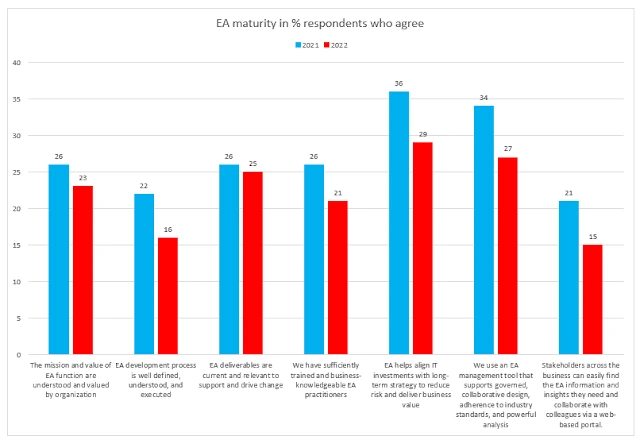Every year, BizzDesign posts the results of its survey on the State of Enterprise Architecture online.
Despite being valuable data, lately it shows a worrying downward trend. A trend that portrays a steady decline of Enterprise Architecture.
To reach this conclusion, I compared the 2021 and 2022 reports. BizzDesign was kind enough to provide me with the 2021 data so that a comparison could be made.
The thing that immediately stands out is that a decrease is visible on all indicators. So this is not a decline with respect to one or two topics; the decline is widely visible.
The hard truth
The chart below shows (a subset of) the questions BizzDesign asks survey participants every year, including their responses.

The full 2022 report can be found here. You have to leave your contact details in order to get access to it.
Without the added value of Enterprise Architecture, processes will remain ineffective and permanently high costs are unmissable.
The graph above is a comparison between 2021 and 2022 and shows the following statistics:
- The mission and value of EA function are understood and valued by organization
- EA development process is well defined, understood, and executed
- EA deliverables are current and relevant to support and drive change
- We have sufficiently trained and business-knowledgeable EA practitioners
- EA helps align IT investments with long-term strategy to reduce risk and deliver business value
- We use an EA management tool that supports governed, collaborative design, adherence to industry standards, and powerful analysis
- Stakeholders across the business can easily find the EA information and insights they need and collaborate with colleagues via a web-based portal
I’d like to zoom in on three of the items in the list.
1. The mission and value of EA function are understood and valued by organization
It cannot but be described as sad that organisations are seeing the added value of the EA function to a decreasing extent. Perhaps even more serious than not seeing it is the fact that organisations also seem to understand it less.
Effectively, this means that an even greater number of organisations, compared to last year, do not see the value of EA. They do not understand what this value can bring them. In other words, organisations continue to operate without the guidance of Enterprise Architecture; unstructured and mainly ad hoc.
2. EA development process is well defined, understood, and executed
As a logical consequence of not seeing the value of EA, we see that the EA process is developed, understood and executed to a lesser extent.
By not investing further in the development (and application) of Enterprise Architecture within an organisation, the structured approach of problem analysis, for example, will fade further into the background.
This means that:
- Ineffective processes will not be addressed (and will therefore remain ineffective)
- Application rationalisation will not be carried out (resulting in permanently high costs)
- The translation from strategy to implementation will hardly be done, if at all (resulting in very few people in the organisation being aware of their role in the bigger picture)
3. We have sufficiently trained and business-knowledgeable EA practitioners
The third issue ties in with the first two points mentioned. Because there is less understanding of the added value of EA, people to fail to see the benefits of hiring architects. This leads to the decline we see in the area of having well-trained architects and EA practitioners. The knowledge and skill architects normally bring with them with regard to understanding and seeing through the organisation is decreasing simultaneously with the realisation of the value of the EA function.
Decline on all fronts
This decline on all fronts might seem difficult to explain when set against the steady growth in certified architects. Apparently, there is still a desire among organisations to train architects and provide them with the opportunity to follow a certification path.
The number of certified architects holding a TOGAF certification continues to grow with a steady 7% annually.
So what triggers this decline?
Personally, I think there are still too many organisations that continue to cling to the now vastly outdated image of an architect as being part of the traditional IT department. Gradually (especially after sending the architect on a course), organisations discover that Enterprise Architecture is more than just IT. The architect in question becomes increasingly involved in all kinds of activities that have nothing to do with IT, but are far more concerned with business issues. Organisations are scratching their heads wondering what the added value of an architect is if he/she does not deal with IT.
The simple fact that organisations have (and seem to maintain) an incomplete and outdated view of the work of an architect is the cause of the decline in the aforementioned use and support of architecture within organisations.
Architects are hardly empowered, if at all.
How to turn this around
I have denounced it before, but organisations need to wake up and realise that we are no longer living in the 1990s. Architecture has continued to evolve over the decades into a mature discipline, one that can act and support organisation-wide and help organisations professionalise further.
When this realisation finally dawns, the use and deployment of architecture within companies will increase.







Leave a Reply